Rome Day 1, Night
Rome Day 1, Night
Linda Miller
A walking trip to see the sites at night with stops to eat snacks and dinner along the way.
Updated ago
1
Share
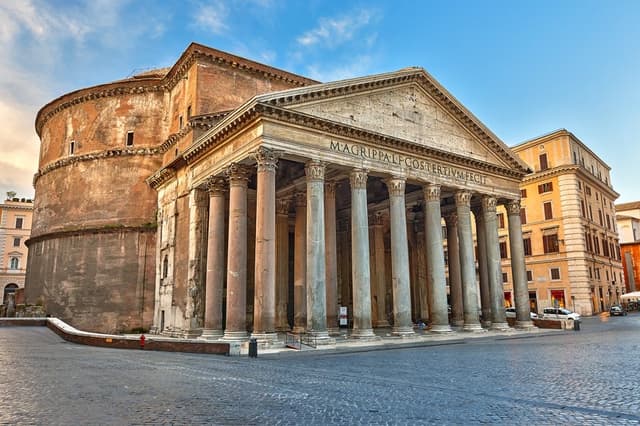
Leave the hotel at 5ish. From the hotel to the Colosseum is a 30-minute walk. Stop and get gelato along the way.
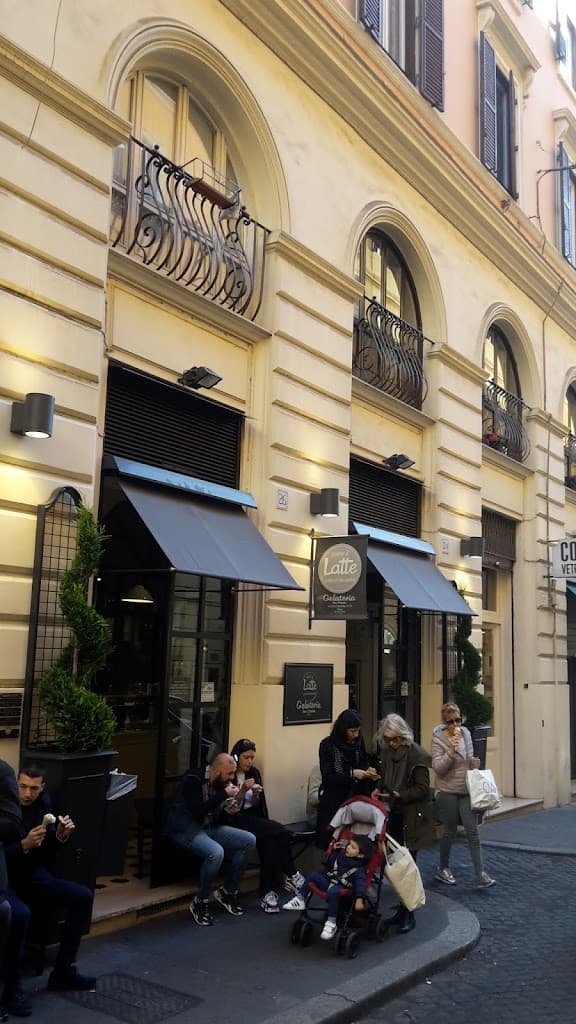
Come il Latte
@lindamiller
Come il Latte is a gelateria located in Rome, Italy. It is known for its high-quality gelato made with fresh, seasonal ingredients. It is highly recommended by locals.
Come il Latte was founded in 2012 by two friends, Marco Radicioni and Alessandro Severini. The two friends were passionate about gelato, and they wanted to create a gelateria that offered the best possible gelato.
Come il Latte uses only the freshest ingredients in its gelato. The milk comes from a local dairy farm, and the eggs are organic. The fruits and nuts are seasonal, and they are sourced from local suppliers.
Come il Latte offers a wide variety of gelato flavors, including both classic and unique flavors. Some of the most popular flavors include:
Stracciatella
Pistachio
Chocolate
Coffee
Hazelnut
Mango
Strawberry
Lemon
Ricotta with pistachio
Ricotta with figs and hazelnuts
Ricotta with cinnamon and chocolate
Ricotta with raspberries and meringue
Come il Latte is a popular destination for both locals and tourists. It is a great place to enjoy a delicious gelato on a hot day.
It is located at Via Silvio Spaventa, 26 in Rome, Italy.
It is open from 12:00 pm to 11:00 pm, seven days a week.
Add to
Details

Church of Santa Maria della Vittoria
@lindamiller
The Church of Santa Maria della Vittoria is a Catholic church located in Rome, Italy. It was built in the 17th century by the Discalced Carmelites, and is known for its masterpiece of Baroque sculpture, the Ecstasy of Saint Teresa by Gian Lorenzo Bernini.
The church was built between 1608 and 1620, and was designed by Carlo Maderno. The facade is a simple design in travertine, with a large central portal and two smaller side doors. The interior of the church is a single nave with a barrel vault, and is decorated with a series of frescoes by Giovanni Lanfranco.
The Ecstasy of Saint Teresa is located in the Cornaro Chapel, which is located to the right of the main altar. The sculpture depicts the Spanish mystic Saint Teresa of Ávila in the throes of a mystical experience. She is shown being pierced by an angel's arrow, which represents the love of God.
The Ecstasy of Saint Teresa is one of the most famous sculptures in the world, and is a masterpiece of Baroque art. It is a dramatic and sensual work that captures the intensity of Saint Teresa's religious experience.
Add to
Details
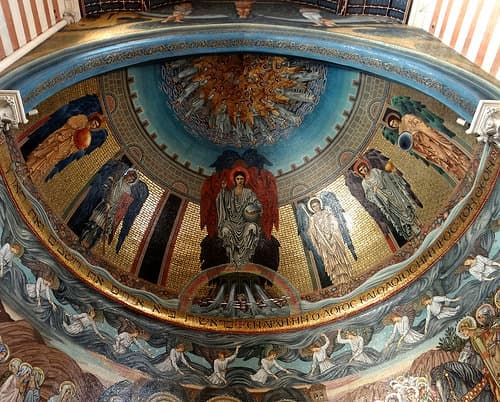
St. Paul's Within the Walls
@lindamiller
Add to
Details
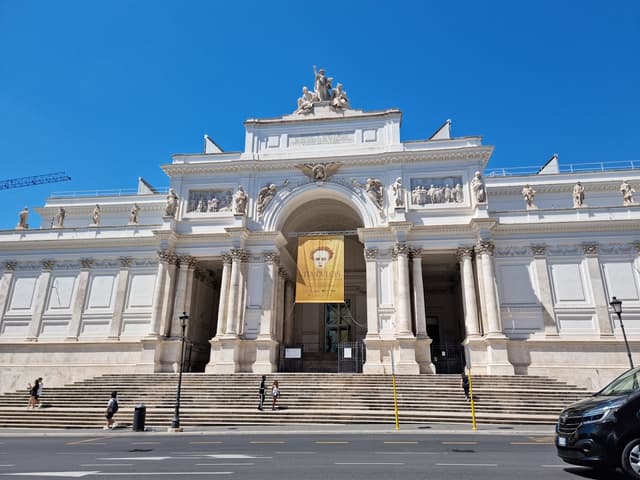
Palazzo delle Esposizioni
@lindamiller
Add to
Details
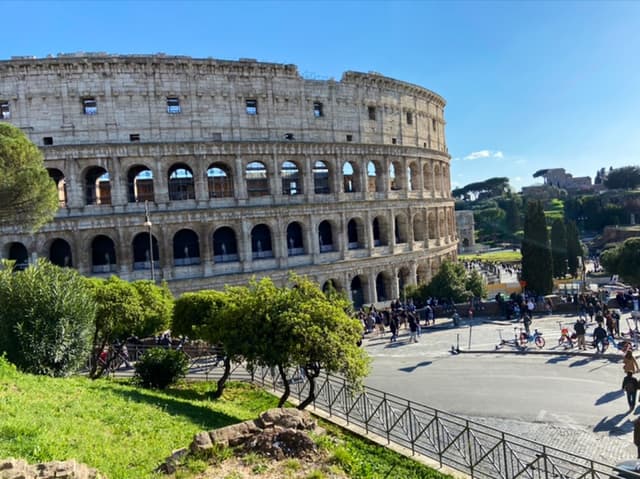
Giardinetto del Monte Oppio
@lindamiller
Add to
Details
Get to the colosseum around 6 pm. Stay 30 minutes.
Trevi Fountain at Night
@lindamiller
The Trevi Fountain at night is a truly magical sight. The fountain is lit up with yellow lights, and the water sparkles in the darkness. The statues and architecture of the fountain are even more impressive at night, and the fountain is less crowded than it is during the day.
At night, there is a romantic atmosphere in the air.
You can enjoy a delicious meal or drink at one of the many restaurants and bars near the fountain. Be sure to bring a camera to capture the beauty of the fountain, and don't forget to make a wish!
Add to
Details
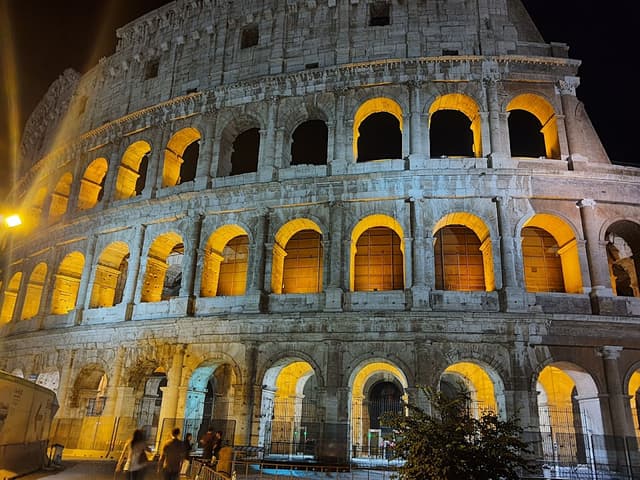
Colosseum at Night
@lindamiller
The Colosseum at night is a truly magical sight. The ancient amphitheater is illuminated in a golden glow, and the shadows of the arches and columns dance across the stones. It is a place where history comes alive, and where you can imagine the gladiators and emperors who once stood in the same spot centuries ago.
There are a few different ways to experience the Colosseum at night. You can take a guided tour, which will give you a chance to learn about the history of the Colosseum and see some of the areas that are not accessible to the public during the day. Or, you can simply wander around on your own and soak up the atmosphere.
No matter how you choose to experience it, the Colosseum at night is an unforgettable experience. It is a place where you can feel the power of history and the magic of Rome.
Here are some tips for visiting the Colosseum at night:
--Book your tickets in advance, especially if you are visiting during the peak season.
--Bring a camera!
--Enjoy the experience and make some memories!
Add to
Details
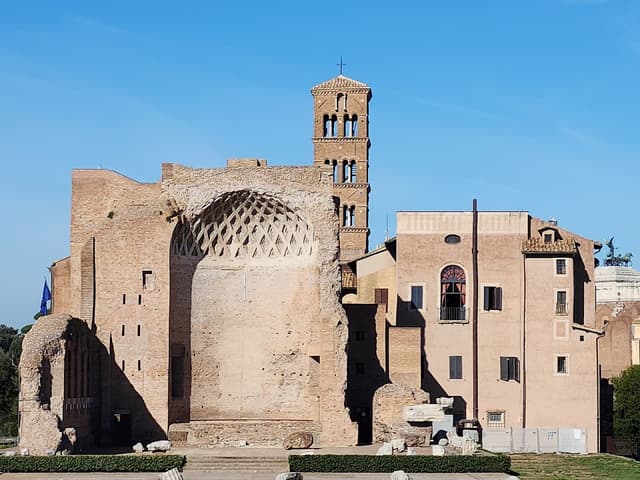
Temple of Venus and Rome
@lindamiller
The Temple of Venus and Rome was one of the largest and most magnificent temples in ancient Rome. It was located on the Velian Hill, between the eastern edge of the Roman Forum and the Colosseum. The temple was dedicated to the goddesses Venus Felix ("Venus the Bringer of Good Fortune") and Roma Aeterna ("Eternal Rome").
The temple was built by the Roman emperor Hadrian and was completed in 135 AD. It was a colossal building, measuring 110 meters (360 feet) long and 53 meters (174 feet) wide. The temple had two main chambers, each housing a cult statue of one of the goddesses.
The Temple of Venus and Rome was a symbol of the power and prestige of the Roman Empire. It was also a popular place of worship for the Roman people. The temple was damaged by fire in 307 AD, but it was restored by the emperor Maxentius.
The Temple of Venus and Rome is now in ruins, but it is still an impressive sight. The remains of the temple can be seen from the Roman Forum and the Colosseum.
Add to
Details
From the colosseum to the Trevi Fountain is a 20 minute walk. Get there around 7. Stay about 15-20 minutes.
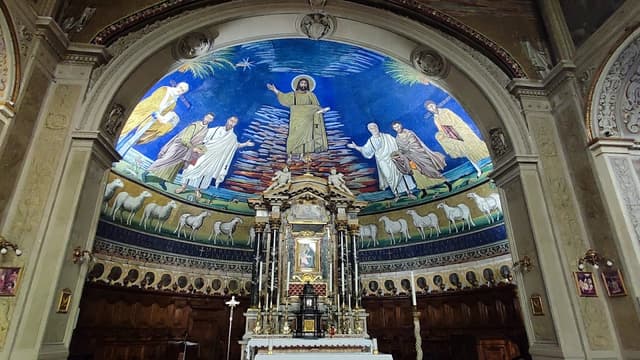
Santi Cosma e Damiano
@lindamiller
The Santi Cosma e Damiano is a basilica church located in the Roman Forum in Rome, Italy. It is dedicated to Saints Cosmas and Damian, two Arabian twin brothers who were martyred in the 4th century AD. The church was built in the 6th century AD and is one of the oldest churches in Rome.
The church is decorated with a variety of mosaics and frescoes. The mosaics in the apse depict the martyrdom of Saints Cosmas and Damian. The frescoes in the nave depict scenes from the Old and New Testaments.
Add to
Details
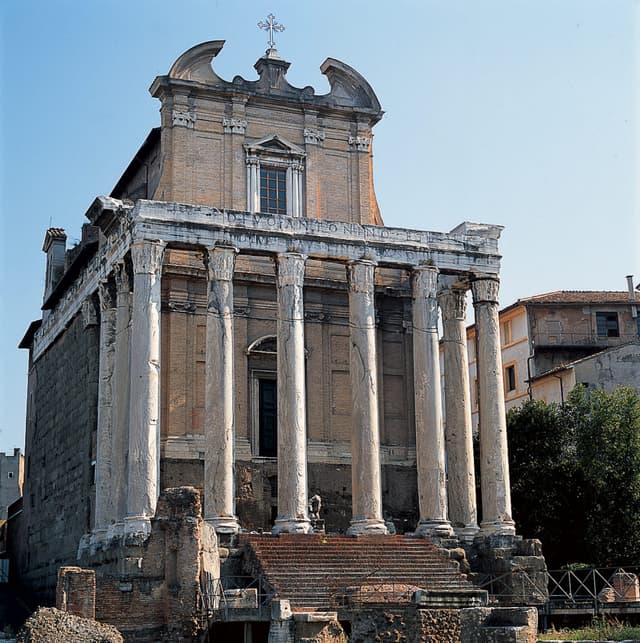
Antoninus and Faustina Temple
@lindamiller
The Temple of Antoninus and Faustina is an ancient Roman temple located in the Roman Forum in Rome, Italy. It was built in 141 AD by the Roman emperor Antoninus Pius to commemorate his deceased and deified wife, Faustina the Elder. After Antoninus Pius died in 161 AD, the temple was re-dedicated to both Antoninus and Faustina.
The temple is a well-preserved example of a Roman temple. It is made of marble and has six columns on the front and back and ten columns on the sides. The temple is decorated with reliefs that depict scenes from the lives of Antoninus and Faustina.
The temple was converted into a Christian church in the 7th century AD. It is still a church today, known as the Church of San Lorenzo in Miranda.
Here are some additional details about the Temple of Antoninus and Faustina:
It is located in the Roman Forum, which is a complex of buildings that was the center of public life in ancient Rome.
The temple is made of marble and is approximately 30 meters (100 feet) long and 17 meters (56 feet) wide.
The temple is decorated with reliefs that depict scenes from the lives of Antoninus and Faustina, such as their marriage, their children, and their apotheosis (deification).
The temple was converted into a Christian church in the 7th century AD and is still a church today, known as the Church of San Lorenzo in Miranda.
Add to
Details
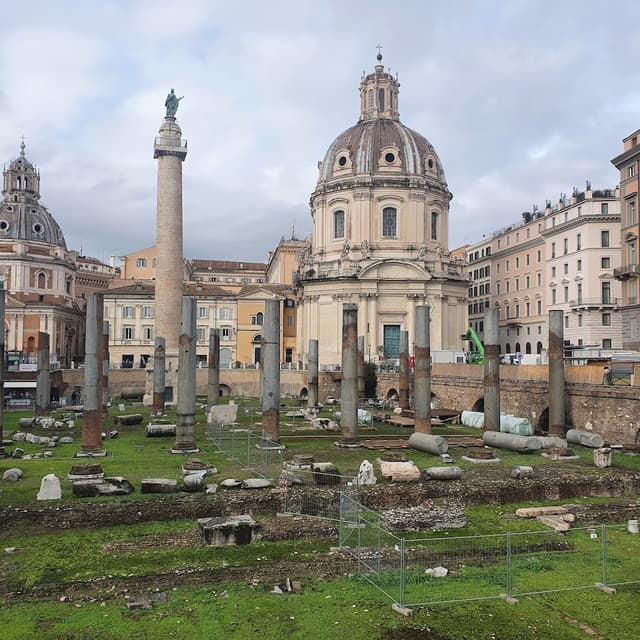
Trajan Forum
@lindamiller
The Forum of Trajan is the last of the Imperial fora to be constructed in ancient Rome. It was built by the Emperor Trajan with the spoils of war from the conquest of Dacia, which ended in 106. The construction began between 105 and 107; according to the Fasti Ostienses the Forum was inaugurated in 112. Trajan's Column was erected and then inaugurated in 113.
The Forum of Trajan is a vast complex, measuring 300 meters (984 feet) long and 185 meters (607 feet) wide. It is located on the Quirinal Hill, just north of the Roman Forum. The forum is surrounded by a colonnaded portico, and it is divided into two main parts: the Forum proper and the Markets of Trajan.
The Forum proper is a rectangular space, surrounded by a portico on three sides. The fourth side is occupied by the Basilica Ulpia, a large law court and administrative building. The forum also includes a temple dedicated to Trajan, a library, and a number of other public buildings.
The Markets of Trajan are a complex of shops, warehouses, and offices. They are located on a series of terraces that descend from the Forum proper to the Via Biberatica. The markets are a masterpiece of Roman engineering, and they are still in use today.
The Forum of Trajan was a major achievement in Roman architecture and urban planning. It was the largest and most impressive of the Imperial fora, and it was a symbol of Trajan's power and prestige. The forum was also a popular place for people to gather and socialize.
The Forum of Trajan is a UNESCO World Heritage Site and is one of the most popular tourist destinations in Rome. It is a reminder of the grandeur and power of ancient Rome.
Here are some of the most notable features of the Forum of Trajan:
Trajan's Column: A 38-meter (125-foot) tall column that commemorates Trajan's victories in Dacia. The column is decorated with a spiral frieze that depicts the Dacian Wars.
Basilica Ulpia: A large law court and administrative building that was one of the largest buildings in the Roman Empire.
Markets of Trajan: A complex of shops, warehouses, and offices that was a major commercial center in ancient Rome.
Temple of Trajan: A temple dedicated to Trajan that was located on the eastern side of the Forum.
Library of Trajan: A library that housed a collection of books and scrolls.
Add to
Details
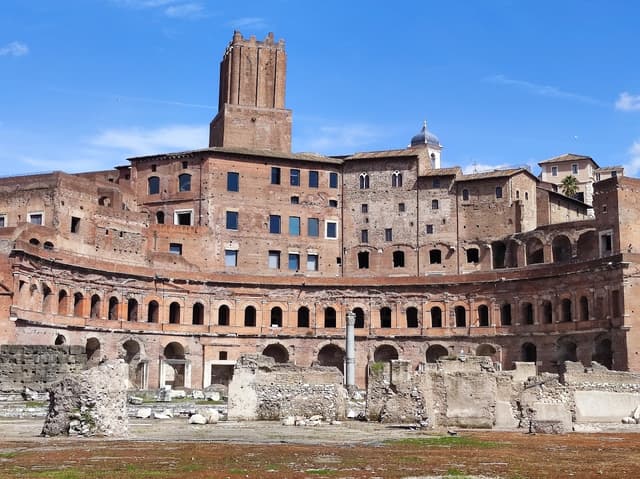
Mercati di Traiano Museo dei Fori Imperiali
@lindamiller
The Mercati di Traiano Museo dei Fori Imperiali is a museum located in Rome, Italy. It is housed in the Trajan's Market, a complex of buildings that was built in the 2nd century AD by the Roman emperor Trajan. The museum houses a collection of artifacts from the Roman Forum and the Imperial Fora, as well as exhibits on the history and architecture of these ancient sites.
The Trajan's Market was a commercial complex that included shops, offices, and warehouses. It was built on the slope of the Quirinal Hill and was connected to Trajan's Forum by a series of ramps and stairs. The market was a major center of trade and commerce in the Roman Empire.
Add to
Details
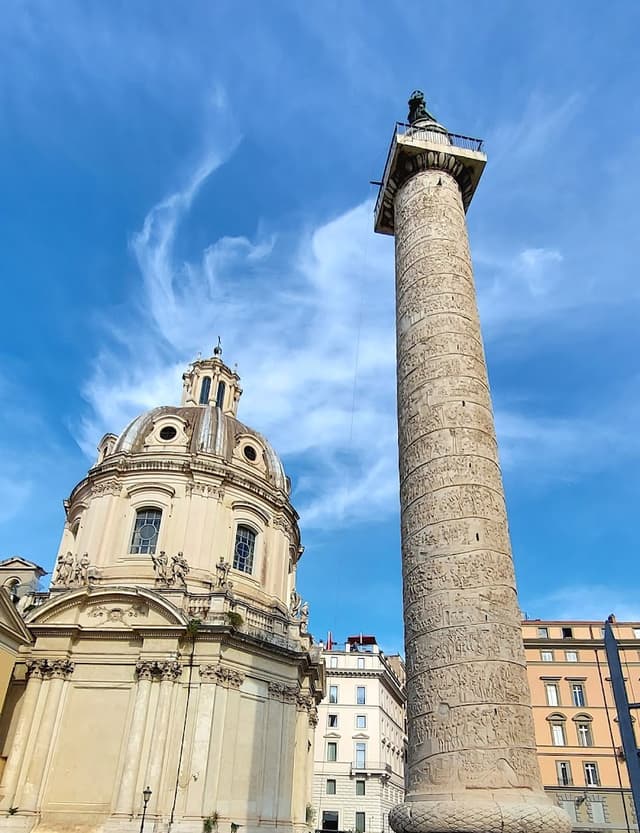
Trajan's Column
@lindamiller
Trajan's Column is a Roman triumphal column located in Rome, Italy. It was built in 113 AD to commemorate the victory of the Roman emperor Trajan over the Dacians in the Dacian Wars. The column is made of marble and is 125 feet (38 meters) high. It is decorated with a spiral band of reliefs that depict the events of the Dacian Wars.
The column is a masterpiece of Roman engineering and art. The reliefs are incredibly detailed and provide a vivid account of the war. The column is also a testament to the power and prestige of the Roman Empire.
Here are some additional details about Trajan's Column:
It is located in Trajan's Forum, which is a complex of buildings that was built by Trajan.
The column is made of 29 blocks of marble, each weighing about 30 tons.
The reliefs on the column depict over 2,500 figures and 150 scenes from the Dacian Wars.
The column is topped by a statue of Trajan, which was replaced by a statue of Saint Peter in the 16th century.
Trajan's Column is a UNESCO World Heritage Site.
Add to
Details
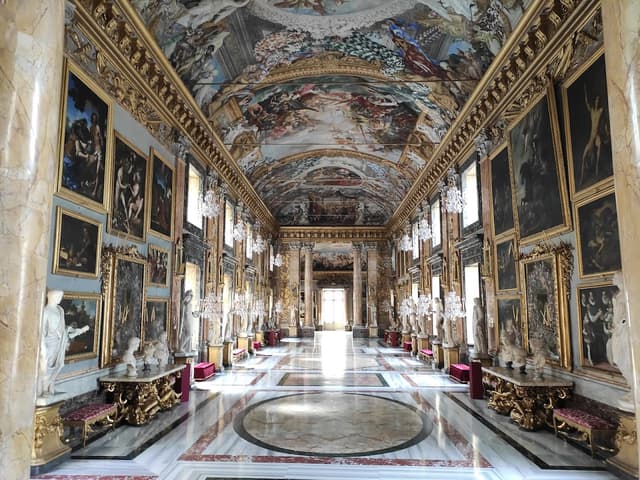
Galleria Colonna Museo e Pinacoteca
@lindamiller
The Galleria Colonna Museo e Pinacoteca is a museum located in Rome, Italy. It is housed in the Palazzo Colonna, which is one of the largest and most important private palaces in Rome.
The museum was founded in the 17th century by the Colonna family, one of the most powerful families in Italy. The collection includes paintings, sculptures, furniture, and other works of art from the 14th to the 18th centuries.
The highlight of the collection is the Galleria Colonna, a long gallery that houses a collection of Italian and Flemish paintings from the 15th and 16th centuries. The gallery includes works by such masters as Raphael, Titian, Tintoretto, and Van Dyck.
Add to
Details
From the fountain to the restaurant is a 10 minute walk. Get there around 7:30. Spend 1.5 hours here and at the store.
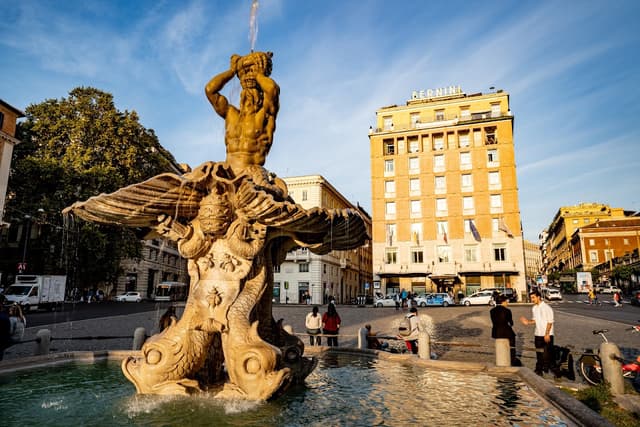
Fontana del Tritone
@lindamiller
The Fountain of the Tritons (Italian: Fontana dei Tritoni) is a Baroque fountain located in Piazza Barberini in Rome, Italy. It was commissioned by Pope Urban VIII Barberini to Gian Lorenzo Bernini in 1643.
The fountain depicts four tritons, mythical creatures with the upper body of a human and the tail of a fish, supporting a large basin. The tritons are depicted as blowing conches, from which water flows into the basin.
The fountain is made of white marble and bronze. It is approximately 13 meters (43 feet) high and 10 meters (33 feet) wide.
The Fountain of the Tritons is one of Bernini's most famous works and is considered to be one of the masterpieces of Baroque sculpture. It is a popular tourist destination and is a must-see for anyone visiting Rome.
Add to
Details
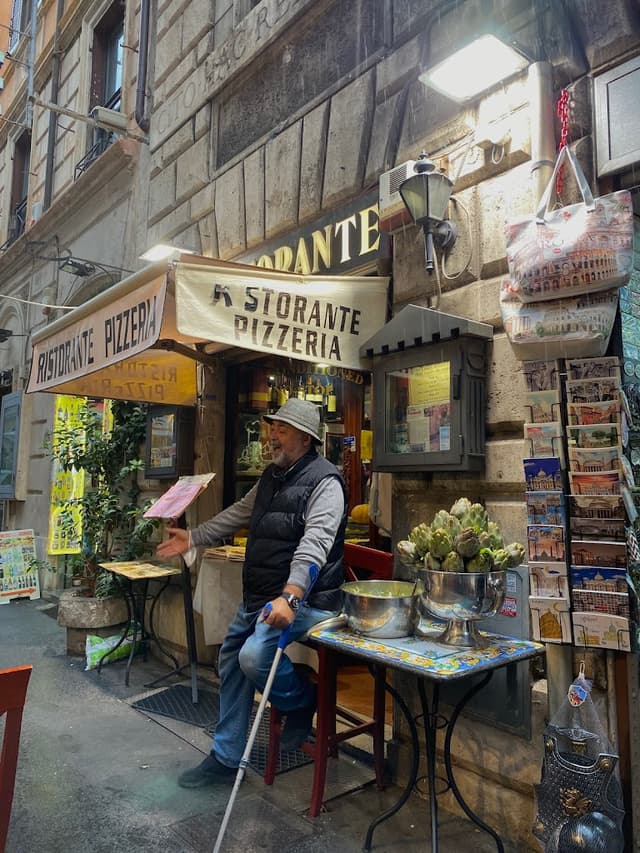
Ristorante "La Tavernetta"
@lindamiller
La Tavernetta 48 is a traditional Italian restaurant located in the center of Rome. It was founded in 1987 by a family of Italian restaurateurs. The family has been running the restaurant ever since, and they are passionate about serving traditional Roman dishes.
The restaurant is located in a small, charming building. The interior is decorated in a traditional Roman style, with exposed brick walls and wooden beams.
The menu at La Tavernetta 48 features a variety of classic Roman dishes. The pasta is made fresh daily, and the sauces are made from scratch. The seafood is fresh from the Mediterranean Sea.
Some of the most popular dishes at the restaurant include:
--Cacio e pepe: This simple but delicious dish is made with spaghetti, grated Pecorino Romano cheese, and black pepper.
--Bucatini all'amatriciana: This hearty dish is made with bucatini pasta, tomato sauce, guanciale, and pecorino Romano cheese.
--Saltimbocca alla romana: This classic dish is made with veal cutlets, prosciutto, and sage.
--Grigliata mista di mare: This mixed grilled seafood platter is a great way to try a variety of fresh seafood.
Here are some reviews of La Tavernetta 48 from TripAdvisor:
--"I had the best pasta of my life here! The cacio e pepe was absolutely perfect. The service was also excellent." - Michele S.
--"This is a true Roman restaurant. The food is delicious and the atmosphere is authentic. I highly recommend it." - Maria G.
--"I had a wonderful meal at La Tavernetta 48. The food was fresh and flavorful, and the service was attentive. I would definitely come back." - John D.
--"Try their mussels (in a sauce of wine, herbs, and chorizo) or the grilled lamb chops. They will prove to you that this is one of the best restaurants in the area." - Sandra B.
Add to
Details

Piazza di Spagna
@lindamiller
The Spanish Steps (Scalinata di Trinità dei Monti) in Rome, Italy, are a monumental staircase of 135 steps linking Piazza di Spagna at the base to Piazza Trinità dei Monti, dominated by the Trinità dei Monti church, at the top.
The Spanish Steps were built in 1723–1725, with funds from the French diplomat Étienne Gueffier. The steps were designed by the architects Francesco de Sanctis and Alessandro Specchi.
The Spanish Steps are one of the most popular tourist attractions in Rome. They are a popular spot for people-watching and taking photos. The steps are also used for a variety of events, such as fashion shows and concerts.
Here are some additional details about the Spanish Steps:
The steps are made of travertine, a type of limestone.
The steps are 135 meters (443 feet) long and 6 meters (20 feet) wide.
The steps are divided into three sections, each with a terrace.
The terraces are decorated with fountains and statues.
The Spanish Steps are a UNESCO World Heritage Site.
If you are visiting Rome, the Spanish Steps are a must-see. They are a beautiful and iconic landmark that offers stunning views of the city.
Here are some tips for visiting the Spanish Steps:
The best time to visit the Spanish Steps is in the early morning or late evening, when they are less crowded.
Be careful when walking up or down the steps, as they can be slippery.
Be respectful of other visitors and avoid blocking the steps.
Enjoy the stunning views of the city from the top of the steps.
Add to
Details
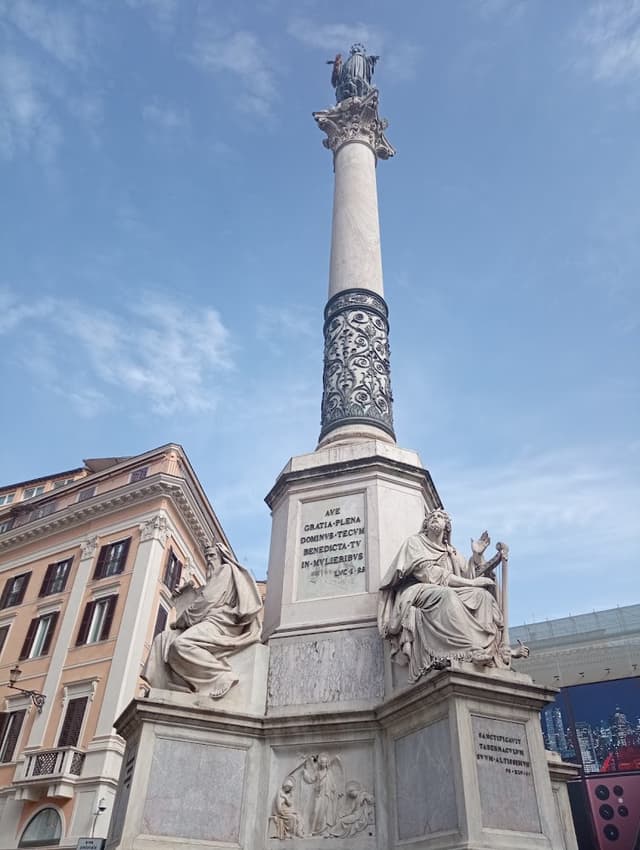
Column of the Immaculate Conception
@lindamiller
The column was dedicated on December 8, 1857, celebrating the doctrine of the Immaculate Conception of 1854. The column is a popular place of pilgrimage for Catholics, who come to pray and revere the Virgin Mary.
The actual structure is a square marble base with statues of biblical figures at the corners that uphold a column of marble of 11.8 meters. Atop the column is a bronze statue of the Virgin Mary, the work of Giuseppe Obici. The statue of the Virgin Mary is 5.4 meters tall.
The Pope traditionally visits the Column of the Immaculate Conception on December 8th, the Feast of the Immaculate Conception. On this day, the Pope leads a Mass in St. Peter's Basilica, and then he goes to Piazza Mignanelli, where the Column of the Immaculate Conception is located. He prays before the column and places a wreath of white roses at its base.
Add to
Details
From here to Popmi Tiramisu is a 10 minute walk. Get there around 9:15. Get something to go.
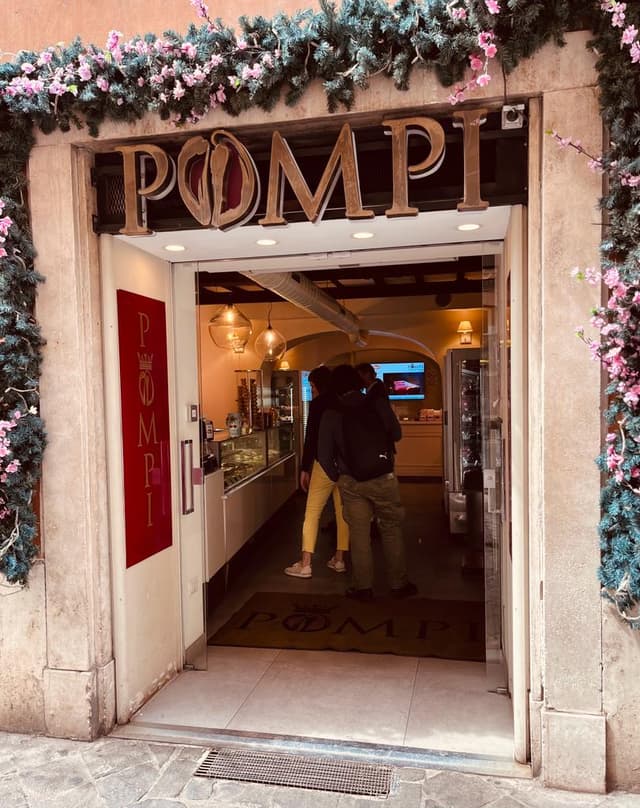
Pompi Tiramisù
@lindamiller
Pompi Tiramisu is a world-famous tiramisu dessert that is made in Rome, Italy. It is a traditional tiramisu, made with ladyfingers soaked in espresso and coffee liqueur, and layered with a rich and creamy mascarpone cheese frosting.
Pompi Tiramisu is made with fresh, high-quality ingredients. The ladyfingers are made with Italian sponge cake, and the espresso is brewed fresh each day. The mascarpone cheese is made with fresh cream and milk, and the coffee liqueur is made with espresso.
Pompi Tiramisu is available in a variety of sizes, from individual portions to large cakes. It is also available in a variety of flavors, including classic tiramisu, chocolate tiramisu, and strawberry tiramisu.
Pompi Tiramisu is a popular dessert among tourists and locals alike. It is a delicious and decadent treat that is perfect for any occasion.
Add to
Details
From here to hotel is a 20 minute walk. Get there ~10. We have to get up early!
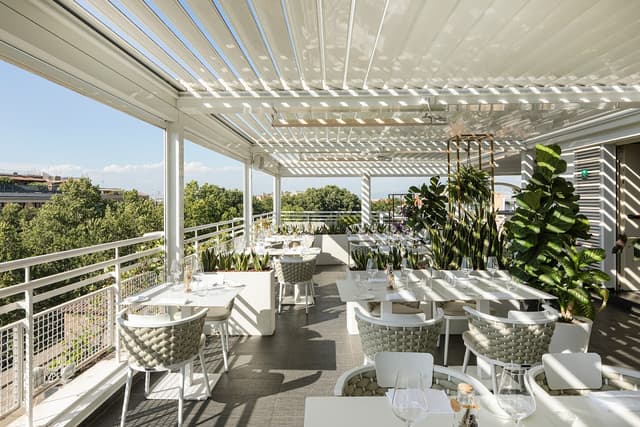
The Tribune Hotel, part of JdV by Hyatt
@lindamiller
The Tribune Hotel, Rome is a stylish hotel located in the heart of the city, just a short walk from the Spanish Steps and the Trevi Fountain. The hotel is housed in a former 19th-century building and has been carefully restored to retain its original character.
Add to
Details
* * *
ABOUT THE AUTHOR
Linda Miller
Read more about places in this guide
Powered by Thatch
The home for unique & authentic travel
The home for unique & authentic travel
Powered by Thatch: Where great trips are made.
© Linda Miller 2025 • Help • Privacy • Terms • Copyright • Become a Seller • Seller Academy • About • Careers • Blog • Explore Places
Ask ThatchGPT
Ask ThatchGPT
Recommend a hotel for my trip
Match me with a local expert to chat with
Brainstorm destination ideas
Suggest a unique Thatch itineries for my trip